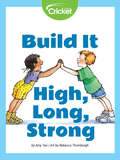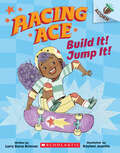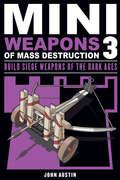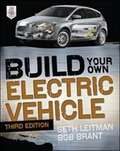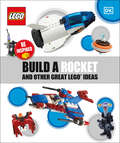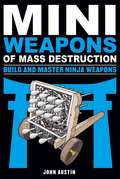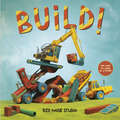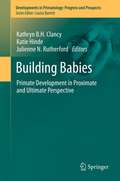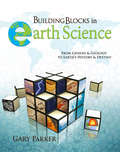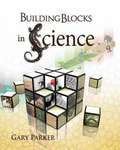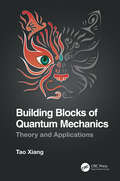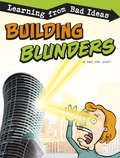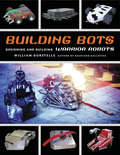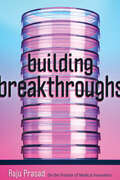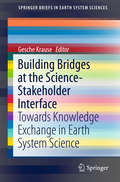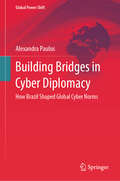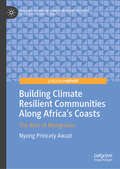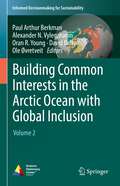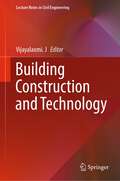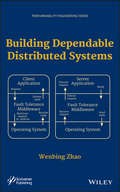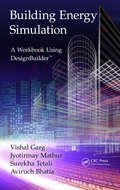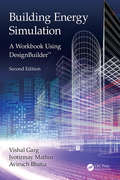- Table View
- List View
Build It High, Long, Strong
by Amy TaoHave you ever wondered how tall and long bridges are built? Learn about three different bridges and try the activities to learn about how strong bridges, like the Golden Gate Bridge, are made.
Build It! Jump It!: An Acorn Book (Racing Ace)
by Larry Dane BrimnerAce builds a cool skateboard and learns how to skate in this fast-paced, STEM-themed early reader!Pick a book. Grow a Reader!This series is part of Scholastic's early reader line, Acorn, aimed at children who are learning to read. With easy-to-read text, a short-story format, plenty of humor, and full-color artwork on every page, these books will boost reading confidence and fluency. Acorn books plant a love of reading and help readers grow!Ace works hard to build a skateboard. She tightens every nut and bolt -- and adds a cool sticker. Then, Ace is ready to skate. But Ace goes too fast and falls down! She will have to try again. Will Ace ever be able to rocket up the ramp?With Larry Dane Brimner's simple text and Kaylani Juanita's full-color artwork on every page, this action-packed book is perfect for new readers!
Build Siege Weapons of the Dark Ages: Build Siege Weapons of the Dark Ages (Mini Weapons of Mass Destruction #3)
by John AustinUtilizing easy-to-find and inexpensive materials, this handy resource teaches desktop warriors how to build a multitude of medieval siege weapons for the modern era. Novice combatants will learn to build 35 defense weapons, including a marshmallow catapult, a chopstick bow, a bottle cap crossbow, and a clothespin ballista. In addition to beefing up their Dark Age arsenal, would-be warriors are provided with a number of targets on which to practice their shooting skills. Clear diagrams, instructions, and safety tips for each project are included, making construction of each of these weapons simple, safe, and fun.
Build Your Own Electric Vehicle (Build Your Own)
by Seth Leitman Bob BrantBUILD, CONVERT, OR BUY A STATE-OF-THE-ART ELECTRIC VEHICLE: Thoroughly revised and expanded, Build Your Own Electric Vehicle, Third Edition, is your go-to guide for converting an internal combustion engine vehicle to electric or building an EV from the ground up. You'll also find out about the wide variety of EVs available for purchase and how they're being built. This new edition details all the latest breakthroughs, including AC propulsion and regenerative braking systems, intelligent controllers, batteries, and charging technologies. <p><p> Filled with updated photos, this cutting-edge resource fully describes each component--motor, battery, controller, charger, and chassis--and provides illustrated, step-by-step instructions on how to assemble all the parts. Exclusive web content features current supplier and dealer lists. Custom-built for environmentalists, engineers, students, hobbyists, and mechanics, this hands-on guide puts you in the fast lane toward a cost-effective, reliable green machine. <p><p> This Third Edition, covers: Environmental impact and energy savings, The best EV for you--purchase trade-offs, conversion trade-offs, and conversion costs, Chassis and design, Different types of electric motors and controllers, Lithium EV batteries, Chargers and electrical systems, EV builds and conversions, Licensing and insuring your EV, Driving and maintenance, List of manufacturers and dealers regularly updated on website.
Build a Rocket and Other Great LEGO Ideas
by DKThis bite-size collection of space-themed LEGO ideas will launch you into a whole new world of creativity.Small in size but big in inspiration, this neat 32-page volume contains a collection of projects from the 'Out of This World' chapter of The LEGO® Ideas Book. These ideas will do more than teach building skills; they will unlock your imagination and get you dreaming up dozens of ideas of your own. And of course, every one of them is great fun. Building that LEGO rocket is a must, but you'll need jet packs, spacewalkers, and moon miners for exploring alien planets. And then there's the aliens themselves, plus their stealth ships and flying saucers. There's all this and lots more inside this book, so dip in - and don't forget, there are four other exciting books in this series, too.©2020 The LEGO Group
Build and Master Ninja Weapons (Mini Weapons of Mass Destruction #4)
by John AustinAuthor and toy designer John Austin provides detailed, step-by-step instructions with diagrams to show stealth warriors how to build 37 different ninja weapons for the modern era. Each of the projects in MiniWeapons of Mass Destruction 4 are built from common household and office items--plastic utensils, markers, clothespins, paper clips, wire hangers, and discarded packaging--all clearly detailed on materials lists. Builders are offered a variety of samurai stars, blowguns, throwing darts, siege weapons, and ninja tools to choose from. Once they've assembled their armory, the author provides novices several targets to construct to practice their shooting skills. Armed, trained, and shrouded in black, readers are now prepared for missions of reconnaissance, sabotage, and other grim errands
Build!
by Red Nose StudioFor all young truck lovers and fans of books like Goodnight, Goodnight, Construction Site! Watch a series of amazing construction vehicles—a dump truck, a bulldozer, and many others—build a building unlike any other. Then delight in the surprise ending, where young readers and listeners can see that the trucks are actually toys that a little boy is playing with!Bulldozers, dump trucks, and cranes are just a few of the vehicles working together in these pages to build something incredible. The payloader makes the hole for the foundation ("DIG"), the semi-loader brings in the huge blocks ("HAUL"), and the crane lifts them up ("HOIST"). But is this a real construction site, or a boy's backyard? And after the structure is done, what happens next? Yes, the inevitable: he makes it all tumble down and is ready to start all over again! Here is an ingenious book that showcases all kinds of trucks and celebrates the joy of imaginative play. But it is also a marvel of ingenuity on the part of Red Nose Studio, who has hand-built each of the trucks, as well as the construction site, then photographed his 3-D creations. As added value, the inside of the jacket—which pictures each vehicle and a simple description of what it does—can be hung in a child&’s room as a poster.
Building Babies: Primate Development in Proximate and Ultimate Perspective (Developments in Primatology: Progress and Prospects #37)
by Julienne N. Rutherford Kathryn B.H. Clancy Katie HindeThe ontogeny of each individual contributes to the physical, physiological, cognitive, neurobiological, and behavioral capacity to manage the complex social relationships and diverse foraging tasks that characterize the primate order. For these reasons Building Babies explores the dynamic multigenerational processes of primate development. The book is organized thematically along the developmental trajectory:conception, pregnancy, lactation, the mother-infant dyad, broader social relationships, and transitions to independence. In this volume, the authors showcase the myriad approaches to understanding primate developmental trajectories from both proximate and ultimate perspectives. These collected chapters provide insights from experimental manipulations in captive settings to long-term observations of wild-living populations and consider levels of analysis from molecule to organism to social group to taxon. Strepsirrhines, New World monkeys, Old World monkeys, apes, and humans are all well-represented. Contributions by anthropologists, microbiologists, psychologists, population geneticists, and other primate experts provide Building Babies a uniquely diverse voice. Building Babies features multi- and trans-disciplinary research approaches to primate developmental trajectories and is particularly useful for researchers and instructors in anthropology, animal behavior, psychology, and evolutionary biology. This book also serves as a supplement to upper-level undergraduate courses or graduate seminars on primate life history and development. In these contexts, the book provides exposure to a wide range of methodological and theoretical perspectives on developmental trajectories and models how researchers might productively integrate such approaches into their own work.
Building Bionic Bodies
by Tracy Vonder Brink Mark HicksDo you know someone who has a prosthetic? Many people that you might see have prosthetics and you cannot even tell! In fact, people have created and used prosthetics for thousands of years! This story shows how prosthetics have changed over time in the way they have been created and allowed mobility. You will also learn how technology has allowed prosthetics to help even more people in ways than they ever have before. Prosthetics help people to walk and run, hear, eat, and to even help them stay alive! Some may say that important pieces of technology have allowed people to become "bionic!"
Building Blocks In Earth Science: From Genesis And Geology To Earth's History And Destiny
by Gary ParkerDevelop critical thinking skills as you explore what to believe and why you believe it! To understand earth science, it requires “teamwork,” combining the methods and evidences of both science and history. And if you also use the “history book of the world,” the Bible, you can make sense of the Earth’s surface — altered, formed, and weathered over time, the landscapes and vistas we enjoy today. Learn about the: - Structure of the Earth and its atmosphere. - Types of minerals and rocks, the water table, and types of volcanoes - Earth's tornadoes, faults, polarity, magnetism, reeds, folding, hypercanes, deltas, and much more! When you understand the difference in history and science in questions related to our planet, you can more effectively discern the evidences seen in the world around you. Science is an awesome tool for understanding the workings of our world and for applying such knowledge to benefit mankind. “Scientific truth” however is not determined by consensus, compromise, majority vote, popularity, celebrity endorsement, money, media endorsement, or best-selling books — and it is at its best when it is rooted in a worldview
Building Blocks in Earth Science
by Dr Gary ParkerDevelop critical thinking skills as you explore what to believe and why you believe it! To understand earth science, it requires "teamwork," combining the methods and evidences of both science and history. And if you also use the "history book of the world," the Bible, you can make sense of the Earth's surface -- altered, formed, and weathered over time, the landscapes and vistas we enjoy today. Learn about the: Structure of the Earth and its atmosphere. Types of minerals and rocks, the water table, and types of volcanoes Earth's tornadoes, faults, polarity, magnetism, reeds, folding, hypercanes, deltas, and much more! When you understand the difference in history and science in questions related to our planet, you can more effectively discern the evidences seen in the world around you. Science is an awesome tool for understanding the workings of our world and for applying such knowledge to benefit mankind. "Scientific truth" however is not determined by consensus, compromise, majority vote, popularity, celebrity endorsement, money, media endorsement, or best-selling books -- and it is at its best when it is rooted in a worldview that begins with the Bible!
Building Blocks in Science
by Dr Gary ParkerHave you ever wondered about human fossils, "cave men", skin color, "ape-men", or why missing links are still missing? Want to discover when T. Rexwas small enough to fit in your hand? Or how old dinosaur fossils are - and how we know the age of these bones? Learn how the Bible's world view (not evolution's) unites evidence from science and history into a solid creation foundation for understanding the origin, history, and destiny of life - including yours! Start reinforcing a strong foundation for learning with study questions, discussions, discussion topics, and more for home and school educators! In this fascinating book, Gary Parker explores some of the most interesting areas of science: fossils, the errors of evolution, the evidence of creation, all about early man and human origins, dinosaurs, and even "races." Learn how scientists use evidence in the present, how historians use evidence of the past, and discover the biblical world view, not evolution, that puts the two together in a credible and scientifically-sound way! Having made his own journey of discovery, this former evolutionary biologist and popular author offers a unique and powerful perspective on the science of our world - past and present. Build your world view on a faith that fits the scientific facts!
Building Blocks of Quantum Mechanics: Theory and Applications
by Tao XiangThis textbook provides a concise yet comprehensive introduction to the principles, concepts, and methods of quantum mechanics. It covers the basic building blocks of quantum mechanics theory and applications, illuminated throughout by physical insights and examples of quantum mechanics, such as the one-dimensional eigen-problem, the harmonic oscillator, the Aharonov-Bohm effect, Landau levels, the hydrogen atom, the Landau-Zener transition and the Berry phase. This self-contained textbook is suitable for junior and senior undergraduate students, in addition to advanced students who have studied general physics (including classical mechanics, electromagnetics, and atomic physics), calculus, and linear algebra.Key features: Presents an accessible and concise treatment of quantum mechanics Contains a wealth of case studies and examples to illustrate concepts Based off the author's established course and lecture notes
Building Blunders: Learning from Bad Ideas (Fantastic Fails)
by Amie Jane LeavittSee some of the world's biggest building blunders up close and personal. Find out how each structure failed, the basic building block that was missed during construction, and what engineers learned from their mistakes.
Building Boats that Float (Fun STEM Challenges)
by Marne VenturaWhat does it take to make a boat float? Gather some supplies and try it out for yourself! Discover tips and ideas on how to build the best boat around!
Building Bots: Designing and Building Warrior Robots
by William GurstelleThis is the definitive guide to designing and building warrior robots like those seen on BattleBots, Robotica, and Robot Wars. It walks robot enthusiasts of all ages step-by-step through the design and building process, enabling them to create any number of customized warrior robots. With a strong emphasis on safety, chapters include designing a robot, choosing materials, radio control systems, electric motors, robot batteries, motor speed controllers, gasoline engines, and drive trains. Clear instructions are accompanied by photos, line drawings, and detailed diagrams throughout. A color section showcases a variety of glorious fighting machines. For beginners, there is machine shop 101 and robot physics, and, of course, chapters on weaponry that include spinner robots, thwackbots, cutting blade robots, lifters, and chameleon robots. When the bot of their dreams is built, suggestions on where to compete and game-day strategies and tactics help readers take the next step. An extensive resource section lists parts suppliers, pertinent Web sites, a radio frequency chart, and a glossary.
Building Breakthroughs: On the Frontier of Medical Innovation
by Raju PrasadFrom mRNA vaccines to gene therapies, the next frontier of medical innovation is here.In Building Breakthroughs, Raju Prasad tells the story of important advancements in biotechnology and medical innovation from gene therapies to mRNA vaccines, providing historical context and examining cutting-edge research. Based on in-depth interviews with both the scientists who developed these discoveries and the patients who have benefited from them, Building Breakthroughs reveals the key players behind drug development and the inner workings of this essential business. Through stories of patients and their families, and of the researchers creating new treatments, Prasad reveals how cell therapies are advancing to treat childhood leukemia and a form of lymphoma, how a gene therapy was established to treat the rare disease spinal muscular atrophy type I, and potentially curative therapies that are being developed for sickle cell disease. By examining the clinical trial and regulatory paths each therapy took to reach approval, Prasad uncovers the building blocks of biotechnology innovation and the investments that must be made to catalyze the development of future breakthroughs. He also explores issues of scientific communication and misinformation, providing recommendations for improvements in the future.For those seeking to understand the vitally important processes that lead to new medicines and the surrounding ecosystem that is enabling the next generation of innovative medicines with the potential to transform patient outcomes, Building Breakthroughs is essential reading.
Building Bridges at the Science-Stakeholder Interface: Towards Knowledge Exchange In Earth System Science (SpringerBriefs in Earth System Sciences)
by Gesche KrauseThis book covers the approaches, applied methods and central participatory processes at the science-stakeholder interfaces embedded in the development of the "Earth System Knowledge Platform (ESKP)". The latter is an initiative of the German Helmholtz Association, synthesizing the expertise of the eight Helmholtz research institutions focusing on Earth System Sciences. The contributions showcase the approach of the Alfred Wegener Institute, Helmholtz Centre for Polar and Marine Research (AWI) within the ESKP initiative. Central focus is placed on the question as to which knowledge transfer processes can be employed to foster meaningful approaches based on science-stakeholder dialogues, data products, and/or modelling. The authors suggest that the tools and approaches for enhancing the vital contributions of science to addressing societal challenges warrant further investigation and development.
Building Bridges in Cyber Diplomacy: How Brazil Shaped Global Cyber Norms (Global Power Shift)
by Alexandra PaulusThis book examines the international forums in which states develop cyber norms—“rules of the road” for how governments use information and communication technologies. To understand the dynamics in this emerging field of diplomacy, the book focuses on an often-overlooked actor: Brazil. With the international debate dominated by two camps that can be broadly characterized as the West versus China and Russia, the book demonstrates that Brazil holds a key position as a bridge-builder between these two sides. It paints a rich picture of Brazil’s efforts in shaping cyber norms across such diverse forums as the United Nations, BRICS, and the Organization of American States, while contextualizing these activities in Brazilian domestic cybersecurity policy and foreign policy traditions. This rich case study paves the way for a deeper understanding of how different actors shape international cybersecurity policy.
Building Climate Resilient Communities Along Africa's Coasts: The Role of Mangroves (Palgrave Studies in Climate Resilient Societies)
by Nyong Princely AwaziThe book "Building Climate Resilient Communities along Africa's Coasts: The Role of Mangroves" highlights the crucial role mangrove ecosystems play in enhancing climate resilience for coastal communities in Africa, which face rising sea levels, intensified storms, and habitat loss. With Africa&’s extensive coastline and dependence on coastal resources, mangroves are essential for protecting communities from environmental stressors, preserving biodiversity, and supporting livelihoods. Each chapter focuses on a specific coastal region in Africa, addressing local challenges, successful case studies, and strategies for integrating mangrove conservation into resilience planning. The book takes an integrative, community-centered approach, combining detailed analyses of mangroves with case studies from across Africa&’s coasts. It emphasizes the importance of understanding the unique ecological and cultural contexts of different regions. Local community engagement in mangrove restoration is covered, highlighting the value of traditional knowledge alongside modern conservation methods. The book also advocates for collaboration among governments, NGOs, and local stakeholders to develop effective policies. By offering actionable recommendations and showcasing the socio-economic benefits of healthy mangrove ecosystems, the book serves as a practical guide for decision-makers and practitioners, aiming to empower communities and inspire action in the fight against climate change and environmental degradation.
Building Common Interests in the Arctic Ocean with Global Inclusion: Volume 2 (Informed Decisionmaking for Sustainability)
by Oran R. Young Paul Arthur Berkman Alexander N. Vylegzhanin David A. Balton Ole Rasmus ØvretveitThis book contains an inclusive compilation of perspectives about the Arctic Ocean with contributions that extend from Indigenous residents and early career scientists to Foreign Ministers, involving perspectives across the spectrum of subnational-national-international jurisdictions. The Arctic Ocean is being transformed with global climate warming into a seasonally ice-free sea, creating challenges as well as opportunities that operate short-to-long term, underscoring the necessity to make informed decisions across a continuum of urgencies from security to sustainability time scales. The Arctic Ocean offers a case study with lessons that are especially profound at this moment when humankind is exposed to a pandemic, awakening a common interest in survival across our globally-interconnected civilization unlike any period since the Second World War. This second volume in the Informed Decisionmaking for Sustainability series reveals that building global inclusion involves common interests to address changes effectively “for the benefit of all on Earth across generations.”
Building Construction and Technology (Lecture Notes in Civil Engineering #360)
by Vijayalaxmi J.This book highlights various aspects of building construction industry based on data from field studies. It discusses the challenges, methodologies, technological applications in building construction, technology, and management. The book presents new approaches to effective building construction and an understanding of the impact of applications of latest technologies. This book is aimed at researchers and professionals in civil engineering and building engineering management to assist in understanding the domain along with recent applications, the advantages, and practical limitations through real-life case studies. This book is useful for building engineers in understanding the effective use of technology, construction methods, and project delivery systems.
Building Dependable Distributed Systems
by Wenbing ZhaoThis book covers the most essential techniques for designing and building dependable distributed systems. Instead of covering a broad range of research works for each dependability strategy, the book focuses only a selected few (usually the most seminal works, the most practical approaches, or the first publication of each approach) are included and explained in depth, usually with a comprehensive set of examples. The goal is to dissect each technique thoroughly so that readers who are not familiar with dependable distributed computing can actually grasp the technique after studying the book.The book contains eight chapters. The first chapter introduces the basic concepts and terminologies of dependable distributed computing, and also provide an overview of the primary means for achieving dependability. The second chapter describes in detail the checkpointing and logging mechanisms, which are the most commonly used means to achieve limited degree of fault tolerance. Such mechanisms also serve as the foundation for more sophisticated dependability solutions. Chapter three covers the works on recovery-oriented computing, which focus on the practical techniques that reduce the fault detection and recovery times for Internet-based applications. Chapter four outlines the replication techniques for data and service fault tolerance. This chapter also pays particular attention to optimistic replication and the CAP theorem. Chapter five explains a few seminal works on group communication systems. Chapter six introduces the distributed consensus problem and covers a number of Paxos family algorithms in depth. Chapter seven introduces the Byzantine generals problem and its latest solutions, including the seminal Practical Byzantine Fault Tolerance (PBFT) algorithm and a number of its derivatives. The final chapter covers the latest research results on application-aware Byzantine fault tolerance, which is an important step forward towards practical use of Byzantine fault tolerance techniques.
Building Energy Simulation: A Workbook Using DesignBuilder™
by Jyotirmay Mathur Aviruch Bhatia Surekha Tetali Vishal GargThis book describes various components and systems of a building and their effect on energy consumption, with the help of an energy simulation tool. The book explains simulation input parameters, along with how to do analysis of the simulation output. With minimal use of mathematical equations, the basics of building physics and energy simulation are explained using words, illustrative examples, charts, tables, and figures.
Building Energy Simulation: A Workbook Using DesignBuilder™
by Jyotirmay Mathur Aviruch Bhatia Vishal GargThe second edition of Building Energy Simulation includes studies of various components and systems of buildings and their effect on energy consumption, with the help of DesignBuilderTM, a front-end for the EnergyPlus simulation engine, supported by examples and exercises. The book employs a "learning by doing" methodology. It explains simulation-input parameters and how-to-do analysis of the simulation output, in the process explaining building physics and energy simulation. Divided into three sections, it covers the fundamentals of energy simulation followed by advanced topics in energy simulation and simulation for compliance with building codes and detailed case studies for comprehensive building energy simulation. Features: Focuses on learning building energy simulation while being interactive through examples and exercises. Explains the building physics and the science behind the energy performance of buildings. Encourages an integrated design approach by explaining the interactions between various building systems and their effect on energy performance of building. Discusses a how-to model for building energy code compliance including three projects to practice whole building simulation. Provides hands-on training of building energy simulation tools: DesignBuilder™ and EnergyPlus. Building Energy Simulation is intended for students and researchers in building energy courses, energy simulation professionals, and architects.
